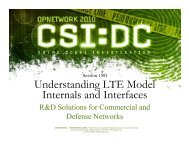Automated Axon Tracking of 3D Confocal Laser Scanning ...
Automated Axon Tracking of 3D Confocal Laser Scanning ...
Automated Axon Tracking of 3D Confocal Laser Scanning ...
You also want an ePaper? Increase the reach of your titles
YUMPU automatically turns print PDFs into web optimized ePapers that Google loves.
1. IntroductionThe orientation <strong>of</strong> motor axons is critical in answering questions regarding synapse eliminationin a developing muscle (Keller-Peck et al., 2001). Biologists have tried to address this issue byidentifying the post-synaptic targets using transgenic mice that express fluorescent proteins insmall subsets <strong>of</strong> motor axons. The post-synaptic targets are the cells innervated by the axons.More specifically, in the neuromuscular system, these are the muscle fibers. At neuromuscularjunctions <strong>of</strong> developing mammals, the developing axonal branches <strong>of</strong> several motor neuronscompete with each other resulting in withdrawal <strong>of</strong> all branches but one (Kasthuri et al., 2003).The biological application <strong>of</strong> the developed algorithm is to reconstruct the entire innervationfield within a skeletal muscle based on images acquired from confocal microscopy. Given a <strong>3D</strong>image stack with non-uniform resolution in the x-, y- and z-direction, it is desirable to segmentmultiple axons contained in the neuron image and reduce them to one-pixel wide medial axis.Our aim here is to better understand the spatial relations <strong>of</strong> groups <strong>of</strong> axons traveling in a nerve.The features revealed by the reconstruction help neuroscientists to understand how neuronsinteract with and control muscular retracting. The size <strong>of</strong> the individual datasets range from 20-30 Megabytes, but when they are joined together to form a collage, they are typically a fewTerabytes in size. Since the data sets to be analyzed are huge, robust and automated algorithmsare needed to track the centerlines <strong>of</strong> the axons accurately.The tracking approaches introduced in the past can be broadly classified into three groups.The first class <strong>of</strong> algorithms tracks the centerlines <strong>of</strong> tubular objects in the Maximum IntensityProjection (MIP) image. As the name suggests, the MIP image along a certain direction is theprojection <strong>of</strong> maximum intensities in the dataset along that direction onto a plane perpendicularto it. This is essentially a data reduction step which provides a 2D image <strong>of</strong> the objects present in3















